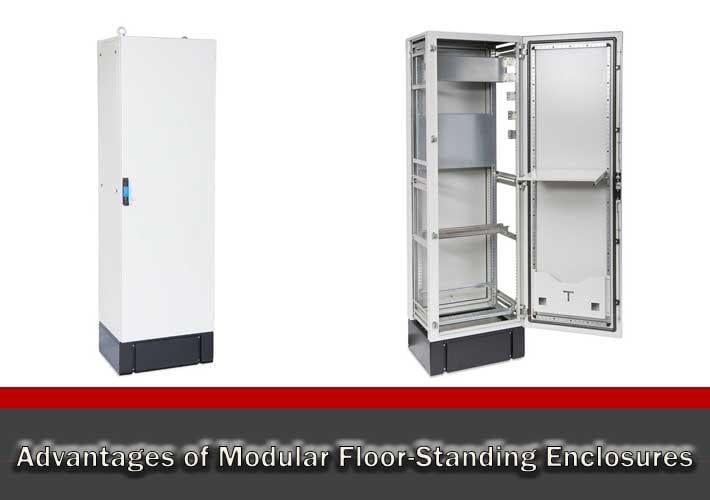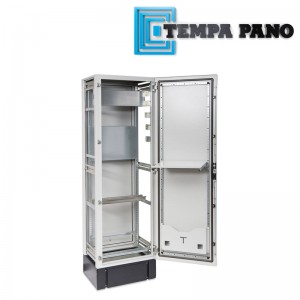Advantages of Modular Floor-Standing Enclosures
Without a doubt, when you are looking for enclosures for your electrical systems and installations, a modular floor-standing enclosure is better than most. Compared to traditional or standard uni-body floor standing enclosures, modular floor-standing enclosures offer a lot more benefits. But the fact is that there is often the mistaken impression that modular floor-standing enclosures are more expensive or are less flexible or versatile, but that’s just not true at all. Here is your guide to modular floor-standing enclosures – and what their real benefits and advantages are.
What is a modular floor-standing enclosure?
The most basic advantage of a modular floor-standing enclosure is its strength – strength that is not only literal, but figurative as well. The frame of a good quality modular floor-standing enclosure will be made from metal, with holes that can be punched in or pre-punched before delivery so users will no longer have to do any welding or drilling when adding accessories. With modular floor-standing enclosures, several frames can be attached to each other (whether it’s side to side, side to back, back to back, top to bottom, and more) so there is a seemingly infinite variety of configurations. What’s more, modular floor-standing enclosures are convenient and easy to use compared to traditional enclosures with one body with metal parts and seams that are already welded together, which do not allow for easier configurations or additions.
It's functions
The primary function of a modular floor-standing enclosure, as you may already know, is to protect workers and staff from the risks of issues with electrical equipment. The second purpose of a modular floor-standing enclosure is to protect the equipment itself from its surrounding environment. Whilst a uni-body floor-standing enclosure offers the same protection as a modular floor-standing enclosure, the modular enclosure offers the added benefit of allowing an integrator, designer, or user to make more varied assemblies, ranging from the most basic to the more complex, according to their needs or requirements.
The main physical distinctions between uni-body and modular floor-standing enclosures
There are a number of differences, most notably physical, between uni-body and modular floor-standing enclosures. First is the hinges or latches. Almost all uni-body cabinets or enclosures make use of piano hinges for the doors. The latching is often accomplished with the use of several clamps which are placed around the perimeter of the door, or a handle. But modular floor-standing enclosures are different. A typical modular floor-standing enclosure will feature captive, discrete or distinct hinging which is not easily noticeable, allowing for better aesthetics.
There is also another difference when it comes to rails. With modular floor-standing enclosures, rails can be added in simply by sliding the panel from the front, the rear, or the side openings. But with uni-body enclosures, the rails can often only be inserted by laying the actual uni-body enclosure or cabinet onto its back and then lifting the unit’s panel with the use of a forklift or a crane.
The intangible distinctions between uni-body and modular floor-standing enclosures
There are also a number of intangible or non-physical distinctions between uni-body and modular floor-standing enclosures. For one, modular floor-standing enclosures allow for a cleaner, more efficient, and more productive plant or production area. The entire floor or area will not only be cleaner and more aesthetically-pleasing, it will not look ‘dated’ as well. With a modern modular floor-standing enclosure with hidden hinges for the doors and single locks (not ugly, noticeable clamps), the plant area becomes more organised and looks more spotless and contemporary.
Another intangible distinction between uni-body floor-standing enclosures and modular floor-standing enclosures is the fact that modular floor-standing units or enclosures offer more flexibility, especially when it comes to making future changes. If the unit needs to be changed or modified, it can be done with ease and convenience, in a much smoother and faster operation. If, by chance, there are any mistakes, these can be easily corrected with a modular floor-standing enclosure compared to a uni-body enclosure.
Some common misconceptions
As mentioned, there are some common misconceptions about modular floor-standing enclosures, particularly in regards to its strength, number of parts, assembly or configuration, and cost. These misconceptions have definitely been proven wrong by some high quality modular floor-standing enclosures today, such as the range of floor-standing enclosures from Tempa Pano.
Let’s take a look at some of these misconceptions – and disprove them:
- Modular floor-standing enclosures lack strength and durability
Some think that since the walls of a modular floor-standing enclosure are thinner than that of a uni-body enclosure, they are less sturdy or strong. This is entirely incorrect. The fact is, the overall strength of a typical modular floor-standing enclosure does not come from its walls, but rather from its frame. This is because the load that is exerted on the modular floor-standing enclosure because of the equipment’s weight is transferred to the enclosure’s vertical framing.
- Modular floor-standing enclosures require a lot of parts that need to be ordered separately
This is another misconception about modular floor-standing enclosures – that a typical enclosure will consist of so many additional parts that need to be ordered separately in order for the enclosure to be fully assembled. The fact is that a typical modular floor-standing enclosure will usually just consist of two main parts: the core assembly or frame (along with the mounting panel) plus the side walls. There are some other parts included as well, such as the door, the mounting plate, the top cover, the rear panel, and the side rails, etc., but these actually allow for easier installation since they are already pre-fitted – and they don’t have to be ordered separately.
Another related misconception about modular floor-standing enclosures is that assembling them requires some special skill or knowledge. This is not true at all – whilst a little bit of work on assembly is necessary, the accessories of the system can be added on by anyone without any special training. With a uni-body floor-standing enclosure, any modification would require more challenging work such as welding, cutting, or bending. With a modular floor-standing enclosure, this is not necessary.
- Modular floor-standing enclosures are more costly than uni-body floor standing enclosures
The fact of the matter is that the price of both modular floor-standing enclosures and uni-body floor-standing enclosures do not differ greatly from each other. They are almost the same price, and, what’s more, if you use a uni-body floor-standing enclosure, there are usually some hidden expenses as well. Also, a uni-body enclosure often has a shorter lifespan than a modular floor-standing enclosure.


